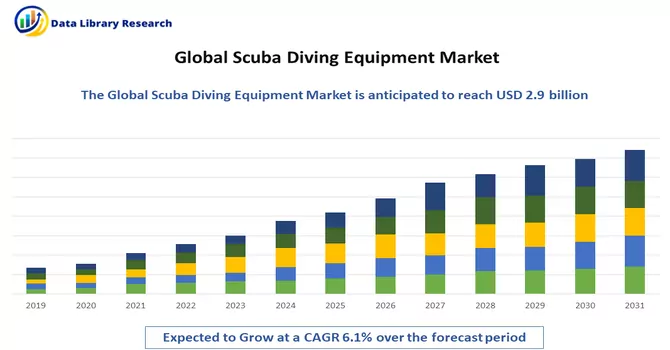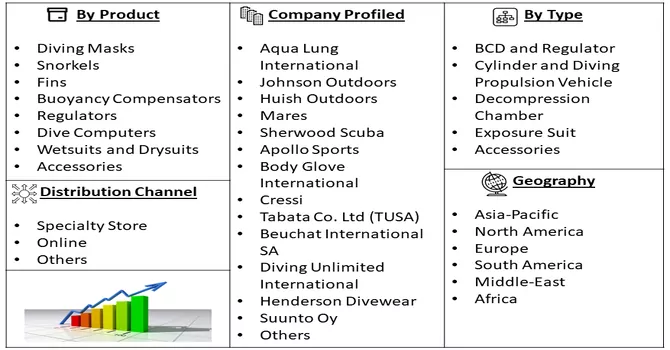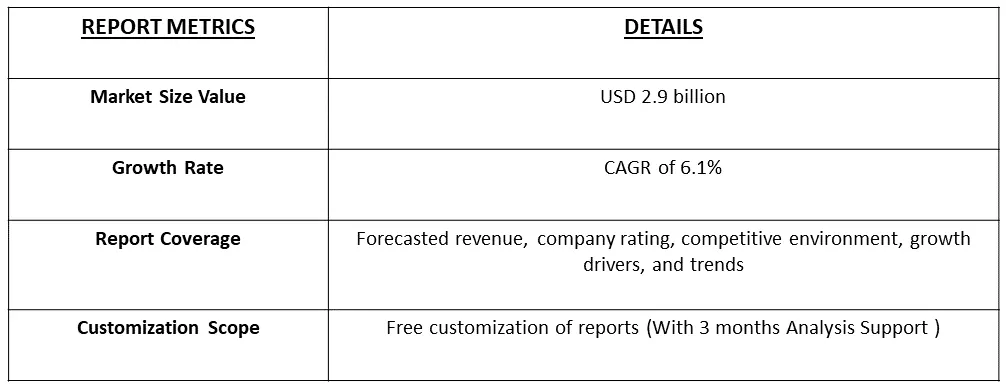The Scuba Diving Equipment Market size was valued at USD 2.9 billion in 2023 and is projected to grow at a CAGR of over 6.1% between 2024 and 2031.

Get Complete Analysis Of The Report - Download Free Sample PDF
The market for scuba diving equipment encompasses a diverse range of gear designed to facilitate underwater exploration and ensure the safety and comfort of divers. Essential equipment includes masks, snorkels, fins, and wetsuits, providing protection, buoyancy, and ease of movement in underwater environments. Dive computers, regulators, and buoyancy compensators are critical components for monitoring depth, managing air supply, and maintaining buoyancy during dives. The market also features advanced technology such as underwater cameras, dive lights, and propulsion devices, catering to enthusiasts seeking to capture underwater moments and enhance their diving experiences. Safety remains a paramount consideration, with emergency signalling devices, dive knives, and dive flags being crucial accessories.
The scuba diving equipment market is characterized by continuous innovation, incorporating lightweight materials, improved design, and advanced features to enhance the overall diving experience while adhering to stringent safety standards. As the popularity of recreational and professional diving continues to grow globally, the scuba diving equipment market remains dynamic, offering a diverse array of products to cater to the evolving needs of underwater enthusiasts.A key growth-driving factor for the scuba diving equipment market lies in the increasing global interest and participation in recreational and professional diving activities. The growing popularity of scuba diving as a leisure pursuit and a sought-after adventure sport is propelling the demand for advanced and specialized diving equipment. As more individuals discover the thrill of exploring underwater ecosystems and experiencing marine life, there is a heightened emphasis on safety, comfort, and performance in scuba gear. Technological advancements, such as lightweight materials, improved design, and innovative features, are attracting both novice and experienced divers, fostering a continuous cycle of equipment upgrades and replacements. Moreover, the rise in eco-tourism and the desire for underwater photography contribute to the demand for specialized equipment like underwater cameras and dive lights. The market is poised to benefit from the expanding global tourism industry and the increasing awareness of marine conservation, as enthusiasts seek to explore diverse underwater environments. This confluence of recreational interest, technological innovation, and environmental consciousness positions the scuba diving equipment market on a trajectory of sustained growth.
Market segmentation: The Report Covers Scuba Diving Equipment Market statistics and it is Segmented by Product (Diving Masks, Snorkels, Fins, Buoyancy Compensators, Regulators, Dive Computers, Wetsuits and Drysuits and Accessories) and Geography (Asia-Pacific, North America, Europe, South America, and Middle-East and Africa).

For Detailed Market Segmentation - Download Free Sample PDF
Market trends in the scuba diving equipment sector reveal a dynamic landscape shaped by evolving consumer preferences and technological advancements. One notable trend is the increasing focus on sustainable and eco-friendly dive gear, reflecting a broader shift towards environmentally conscious practices within the diving community. Manufacturers are incorporating recycled materials, reducing packaging waste, and developing products with a lower environmental impact. Additionally, there is a rising demand for compact and travel-friendly scuba gear, catering to divers seeking convenience and portability in their equipment. Technological innovation continues to play a significant role, with the integration of smart features in dive computers, underwater communication devices, and high-resolution underwater cameras. The market is also witnessing a surge in the popularity of full-face masks, offering enhanced comfort and ease of communication underwater. As the industry embraces digitalization, online platforms for equipment sales, rental services, and virtual dive experiences are gaining prominence. Overall, the scuba diving equipment market trends reflect a harmonious blend of sustainability, technological innovation, and user-centric design to meet the diverse and evolving needs of the global diving community.
Market Drivers:
The global surge in adventure tourism
The global surge in adventure tourism represents a robust driver for various industries, including the scuba diving equipment market. As individuals seek more immersive and adrenaline-pumping experiences, adventure tourism has witnessed a significant upswing. Scuba diving, in particular, has become a focal point for adventure enthusiasts looking to explore the mesmerizing world beneath the ocean's surface. The allure of discovering vibrant coral reefs, encountering diverse marine life, and exploring underwater caves has contributed to the growing popularity of scuba diving as a thrilling adventure activity. Tourist destinations with rich marine ecosystems are increasingly attracting travellers seeking not only picturesque landscapes but also unique and memorable underwater experiences. This surge in adventure tourism has a direct impact on the demand for high-quality, reliable scuba diving equipment, as enthusiasts equip themselves with the latest gear to enhance safety, comfort, and overall enjoyment during their underwater escapades. As the global adventure tourism trend continues to gain momentum, the scuba diving equipment market is well-positioned to capitalize on this surge in interest and cater to the needs of an expanding and diverse customer base.
Ongoing technological innovations in scuba diving equipment act as a driving force.
Ongoing technological innovations in scuba diving equipment stand as a driving force propelling the industry forward. Manufacturers in the scuba diving equipment market are continually pushing the boundaries of design and functionality, introducing cutting-edge technologies to enhance diver safety, comfort, and overall underwater experiences. Advanced materials, such as lightweight yet durable alloys and high-performance fabrics, contribute to the creation of more streamlined and efficient gear. Dive computers equipped with sophisticated algorithms provide real-time data on dive profiles, decompression times, and other critical information, enhancing safety protocols. Underwater communication devices and integrated smart features cater to the demands of tech-savvy divers, fostering a more connected and informed diving community. Additionally, innovations in propulsion devices, buoyancy control systems, and underwater lighting contribute to a comprehensive suite of high-tech equipment. The ongoing commitment to technological advancements not only drives consumer interest but also ensures that scuba diving remains an accessible and evolving adventure sport, attracting enthusiasts and professionals alike to explore the wonders of the underwater world.
Market Restraints:
The scuba diving equipment market faces several market restraints that impact its growth and overall dynamics. Firstly, the high initial cost of acquiring scuba diving gear serves as a significant impediment. Quality scuba equipment, including regulators, buoyancy compensators, and dive computers, can be relatively expensive, posing a barrier for potential divers, especially those entering the sport for the first time. Additionally, ongoing maintenance, servicing, and the need for periodic equipment upgrades contribute to the overall cost of ownership, influencing purchasing decisions. Secondly, concerns related to the environmental impact of scuba diving activities present a challenge. The diving community is increasingly aware of the potential ecological consequences of underwater exploration, such as damage to delicate coral reefs or disturbances to marine life. This environmental consciousness may influence purchasing decisions, with divers seeking sustainable and eco-friendly gear, but it also raises questions about the industry's overall environmental footprint. Thirdly, the complexity of scuba diving equipment can be daunting for beginners, potentially discouraging newcomers from engaging in the sport. The extensive training required to use the equipment safely, coupled with concerns about diver safety, can create a perception of a steep learning curve, limiting the market's expansion. Finally, the scuba diving industry is inherently linked to tourism, and global events, travel restrictions, and economic downturns can impact the frequency and willingness of individuals to undertake diving excursions. External factors such as these can lead to fluctuations in demand, affecting the overall growth trajectory of the scuba diving equipment market. Addressing these challenges requires industry efforts to mitigate costs, enhance environmental sustainability practices, streamline training processes, and adapt to changing global circumstances.
The COVID-19 pandemic has significantly impacted the scuba diving equipment market, creating a complex set of challenges and opportunities for the industry. Travel restrictions, lockdowns, and safety concerns have led to a temporary downturn in the demand for scuba diving equipment as leisure and adventure travel faced disruptions. Diving centers and shops experienced closures or limited operations, impacting the purchasing patterns of both beginners and experienced divers. However, the industry has responded with resilience, adapting to the circumstances by focusing on local markets, promoting online sales, and offering virtual training and certification programs to maintain engagement with enthusiasts. The pandemic has also prompted a heightened emphasis on safety and hygiene protocols within the diving community, influencing equipment preferences. As global travel gradually resumes, the market is expected to recover, with a renewed interest in scuba diving as individuals seek outdoor and adventure activities. The long-term impact underscores the industry's need for flexibility, innovation, and a strategic shift toward digital engagement to navigate the challenges and shape the future of the scuba diving equipment market.
Segmental Analysis:
Buoyancy compensators (BCs) Segment is Expected to Witness Significant Growth Over the Forecast Period
Buoyancy compensators (BCs) are essential pieces of equipment in scuba diving, offering several advantages that enhance safety, comfort, and overall diving experience. One key advantage is their ability to control buoyancy, allowing divers to achieve neutral buoyancy at different depths. This not only conserves energy but also enables divers to maintain proper depth and position in the water, enhancing their control and stability underwater. BCs also provide additional buoyancy at the surface, allowing divers to float effortlessly and conserve energy while preparing to descend or waiting for pickup. Moreover, BCs serve as a safety device, providing divers with a means to quickly ascend to the surface in case of an emergency. By inflating the BC, divers can rise rapidly, bypassing potential hazards or reaching the surface to address issues such as equipment malfunctions or injury. BCs also offer storage options for accessories such as dive lights, surface marker buoys, and spare diving masks, allowing divers to carry essential gear hands-free. Overall, buoyancy compensators play a crucial role in scuba diving, offering divers enhanced control, safety, and convenience underwater.
Asia Pacific Region is Expected to Witness Significant Growth Over the Forecast Period
Asia Pacific is experiencing a growing trend in the use of scuba diving equipment, driven by several factors. One key factor is the region's increasing affluence and disposable income, which has led to a rise in recreational activities such as scuba diving. Countries like Australia, Indonesia, Thailand, and the Philippines are renowned for their stunning dive sites, attracting diving enthusiasts from around the world. Additionally, the region's vast coastline and abundant marine life make it a prime destination for underwater exploration. Moreover, the growing awareness of marine conservation and the importance of preserving marine ecosystems has led to a surge in eco-tourism and diving expeditions focused on marine conservation efforts. This trend has fueled the demand for high-quality, environmentally friendly diving equipment that meets conservation standards. Furthermore, advancements in technology have made scuba diving equipment more accessible and user-friendly, attracting a wider range of enthusiasts, from beginners to experienced divers. The availability of online platforms for booking diving trips and purchasing equipment has also contributed to the growth of the scuba diving market in Asia Pacific. Thus, the growing popularity of scuba diving as a recreational activity, combined with increasing environmental awareness and technological advancements, is driving the use of scuba diving equipment in the Asia Pacific.

Get Complete Analysis Of The Report - Download Free Sample PDF
The analyzed market exhibits a high degree of fragmentation, primarily attributable to the presence of numerous players operating on both a global and regional scale. The competitive landscape is characterized by a diverse array of companies, each contributing to the overall market dynamics. This fragmentation arises from the existence of specialized solution providers, established industry players, and emerging entrants, all vying for market share. The diversity in market participants is underscored by the adoption of various strategies aimed at expanding the company presence. On a global scale, companies within the studied market are strategically positioning themselves through aggressive expansion initiatives. This often involves entering new geographical regions, targeting untapped markets, and establishing a robust global footprint. The pursuit of global expansion is driven by the recognition of diverse market opportunities and the desire to capitalize on emerging trends and demands across different regions. Simultaneously, at the regional level, companies are tailoring their approaches to align with local market dynamics. Regional players are leveraging their understanding of specific market nuances, regulatory environments, and consumer preferences to gain a competitive edge. This regional focus allows companies to cater to the unique needs of local clientele, fostering stronger market penetration. To navigate the complexities of the fragmented market, companies are implementing a range of strategies. These strategies include investments in research and development to stay at the forefront of technological advancements, mergers and acquisitions to consolidate market share, strategic partnerships for synergies, and innovation to differentiate products and services. The adoption of such multifaceted strategies reflects the competitive nature of the market, with participants continually seeking avenues for growth and sustainability. In essence, the high fragmentation in the studied market not only signifies the diversity of players but also underscores the dynamism and competitiveness that drive ongoing strategic maneuvers. As companies explore various avenues for expansion, the market continues to evolve, presenting both challenges and opportunities for industry stakeholders.
Some of the key market players working in this market are:
Recent Development:
1) In August 2023, the first ship of the Five Diving Support Craft (DSC) project, named DSC A 20’ (Yard 325), was launched by M/s Titagarh Rail Systems Ltd (TRSL) in Kolkata for the Indian Navy. This launch ceremony, held on 31 August 23 at Titagarh, Kolkata, and presided over by VAdm Sanjay Mahindru, Deputy Chief of Naval Staff (DCNS), marked a significant milestone in naval construction. The ship was launched onto the Hooghly River, following naval tradition where Mrs. Aradhana Mahindru performed the launching ceremony with an invocation from the Atharva Veda. This development is likely to have a positive impact on the scuba diving market, particularly in India. The Diving Support Craft (DSC) project indicates the Indian Navy's focus on enhancing its diving capabilities, which may lead to increased demand for scuba diving equipment and services. As the Indian Navy expands its underwater operations and diving activities, there could be a corresponding increase in the need for specialized diving equipment, training, and maintenance services. This could create new opportunities for businesses involved in the scuba diving industry, potentially leading to growth and expansion in this sector.
Q1. What was the Scuba Diving Equipment Market size in 2023?
As per Data Library Research the Scuba Diving Equipment Market size was valued at USD 2.9 billion in 2023.
Q2. At what CAGR is the Scuba Diving Equipment Market projected to grow within the forecast period?
Scuba Diving Equipment Market is projected to grow at a CAGR of over 6.1% during the forecast period.
Q3. What are the factors driving the Scuba Diving Equipment market?
Key factors that are driving the growth include global surge in adventure tourism and Ongoing technological innovations in scuba diving equipment act as a driving force.
Q4. Which region has the largest share of the Scuba Diving Equipment market What are the largest region's market size and growth rate?
Asia-Pacific has the largest share of the market. For detailed insights on the largest region's market size and growth rate request a sample here.
Data Library Research are conducted by industry experts who offer insight on industry structure, market segmentations technology assessment and competitive landscape (CL), and penetration, as well as on emerging trends. Their analysis is based on primary interviews (~ 80%) and secondary research (~ 20%) as well as years of professional expertise in their respective industries. Adding to this, by analysing historical trends and current market positions, our analysts predict where the market will be headed for the next five years. Furthermore, the varying trends of segment & categories geographically presented are also studied and the estimated based on the primary & secondary research.
In this particular report from the supply side Data Library Research has conducted primary surveys (interviews) with the key level executives (VP, CEO’s, Marketing Director, Business Development Manager and SOFT) of the companies that active & prominent as well as the midsized organization
FIGURE 1: DLR RESEARH PROCESS

Extensive primary research was conducted to gain a deeper insight of the market and industry performance. The analysis is based on both primary and secondary research as well as years of professional expertise in the respective industries.
In addition to analysing current and historical trends, our analysts predict where the market is headed over the next five years.
It varies by segment for these categories geographically presented in the list of market tables. Speaking about this particular report we have conducted primary surveys (interviews) with the key level executives (VP, CEO’s, Marketing Director, Business Development Manager and many more) of the major players active in the market.
Secondary ResearchSecondary research was mainly used to collect and identify information useful for the extensive, technical, market-oriented, and Friend’s study of the Global Extra Neutral Alcohol. It was also used to obtain key information about major players, market classification and segmentation according to the industry trends, geographical markets, and developments related to the market and technology perspectives. For this study, analysts have gathered information from various credible sources, such as annual reports, sec filings, journals, white papers, SOFT presentations, and company web sites.
Market Size EstimationBoth, top-down and bottom-up approaches were used to estimate and validate the size of the Global market and to estimate the size of various other dependent submarkets in the overall Extra Neutral Alcohol. The key players in the market were identified through secondary research and their market contributions in the respective geographies were determined through primary and secondary research.
Forecast Model
